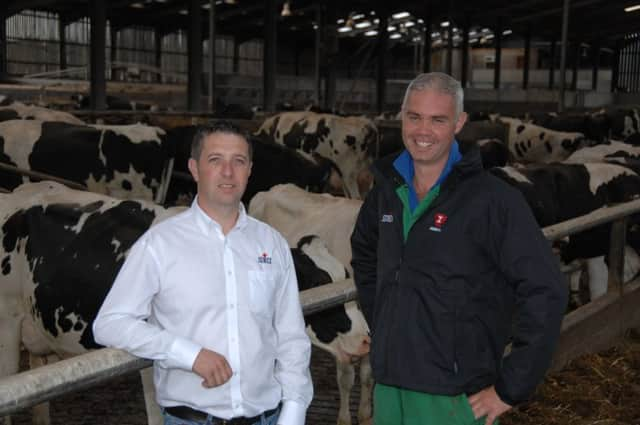Sexed success powers progress


This is certainly a key strategy for the Steele Family, of Rowreagh Farms, Kircubbin, Co Down.
William and Rosemary started their own dairy business in 1980 with 120 cows, but now with their sons Samuel and Thomas, numbers total over 500 cows put through a 60-point rotary parlour and milked three times a day… in just two hours! The herd currently averages an impressive of 10,500kgs of milk sold per cow, at 3.98% butterfat and 3.23% protein.
Advertisement
Advertisement
The herd has grown and developed dramatically in recent years, and this expansion has been aided by using Semex SEXXED™ semen across the herd. Sires were chosen with milk yield / type / milk constituents / increasing disease resistance in mind, and included Sandyvalley Afterburner and Croteau Lesperron Unix. Now the aim is to make further rapid progress to 600 cows, again using the fast track genetic benefits that sexed semen brings. Helping the farm to narrow down the choice of sires is Semex advisor John Berry, using the firm’s SemexWorks™ sire selection program.
The herd’s fertility had been outsourced in recent years, but costs were mounting and the fertility was not at a level that justified the cost, believed Thomas. The lack of precise timing of inseminations, plus an overuse of straw at a whopping 3.5 per pregnancy made the system increasingly financially unstainable, especially when using a premium product like sexed semen. Now, though, a comprehensive re-evaluation of the breeding strategy and the adoption of a new daily fertility regime has brought the straw use down to 1.9 per pregnancy. This is a saving of 1.5 straws, which adds up to an annual saving of 750 straws. This is worth several thousand pounds in savings over the course of a year.
“Success comes through a partnership of our vet, Jason Graham, who is a fertility expert, our nutritionist Keith Agnew from United Feeds and our Semex consultant, John Berry,” Thomas states. “The secret to getting results from sexed semen is not just one factor it’s a combination of a number of factors and experts all working together to cover heat detection, feeding, condition at breeding, and dry cow management,” he adds. Technology also plays a part, states John Berry: “Our SEXXED™ semen is produced under license using SexedUltra™ and it’s the best sexing technology available. We are seeing conception rates on cows comparable to those achieved on maiden heifers. The success of the product is seeing demand growing year on year,” he adds.
Heat detection is now assisted by the software that is integrated into the parlour. The cows are condition scored, weighed and recorded as they exit the parlour, for example. When the cows are on heat a list is generated and checked at every milking. If a cow is in heat she will be served – but ONLY if she has a positive energy balance and is gaining weight. If a bulling cow is in a negative energy balance, and losing weight, she won’t be served.
Advertisement
Advertisement
Also boosting the fertility is the use of phosphate glycol in the parlour for freshly calved cows. When they join the herd they are given 100ml of it sprayed straight onto their parlour ration for two days. This “oral sugar” acts as an energy boost and reduces the risk of ketosis. The aim is to serve the cows at around 50 days, and to this end the cows are checked at 21 days, and again three weeks later. If they are not cycling they are placed on an off-sync program.
The calving season begins from mid-August and carries on to the end of March. This creates a more relaxed approach to calving rather than one with over-loaded stresses created by a tight calving pattern, says Thomas. “The herd has little or no disease or calving related diseases like LDAs, he says. Previously it was common to have 14 to 15 LDAs each year, but now we may have two and last year we had none.”
Dry cow management is also a key part of the process. Dry cows must have a condition score of 2.5 to 3, he insists. Nutrition plays a critical part in this.
Going forward the farm will be focusing on breeding to improve the herd’s feet and legs and udder conformation, followed by SCC and fertility. To assist with this John will be increasingly using the latest breeding technology available from Semex - the Optimate™ breeding program. This creates a herd specific index to ensure that sires that match Thomas’ criteria always come to the fore. He will also be looking to the long-term to address the herd’s antibiotic usage by using Immunity+ sires.